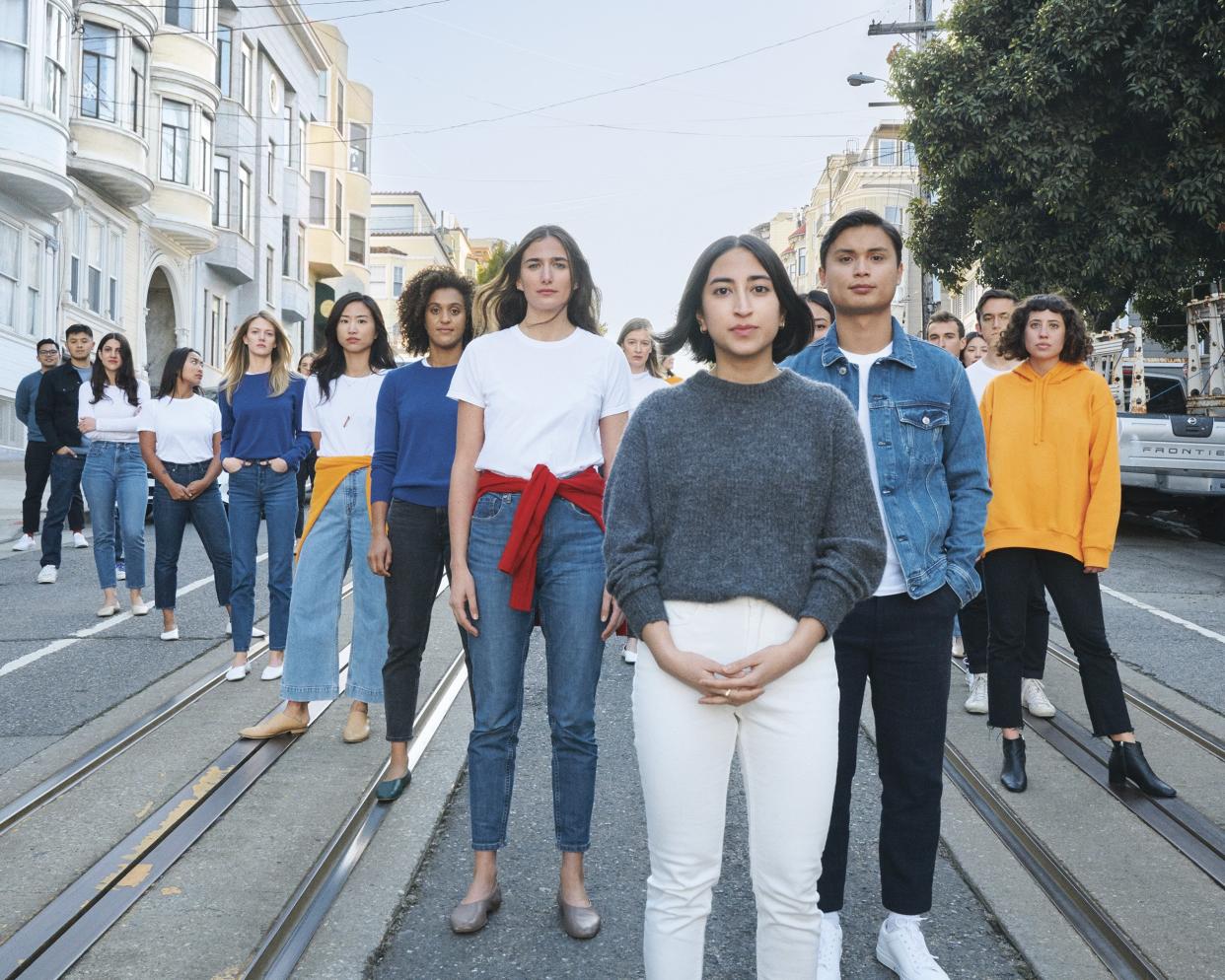Has Everlane Ushered in a Brave New World of Retail?

It’s lunchtime at the Everlane headquarters in San Francisco’s Mission District, and men and women in their early 20s to early 40s mill about the open kitchen preparing salads and sandwiches from the two industrial-size refrigerators stocked with organic food. The employees embody the direct-to-consumer clothing company’s demographic: conscientious young people working in a corporate culture that doesn’t require suits and stilettos but rather Allbirds and earbuds. Or, in this office, Everlane’s leather ballet flats and cashmere crewnecks.
A former laundry facility, the offices are white and bright, with sunlight filtering through the sawtooth skylight onto the open-plan desks. A dry-erase board stands next to the kombucha keg, covered in jagged, teenage-boy handwriting: “The ethical choice is the right one;” “Great design improves people’s lives;” “Smart risks are worth taking.” The notes are left over from the weekly all-hands meeting, explains founder Michael Preysman. Like the ideas, the handwriting is his.
Handsome and tall, with a dense, furry beard, Preysman wears head-to-toe Everlane and a semi-fixed skeptical expression, except when discussing the company he started eight years ago. The son of Russian computer scientists, Preysman grew up in Silicon Valley and attended the same high school as Steve Jobs and Steve Wozniak, just blocks away from where Apple was building the Infinite Loop. “You’re surrounded by this idea that anything’s possible, and that had a big imprint on my life,” he says. But at 25, he found himself toiling away in private equity, unmotivated and disillusioned. Eager to create something tangible, he quit his job. With no more than a general awareness of clothing’s exponential markup, he set out to sidestep the traditional wholesale cost-ratcheting. “It really started with ‘Whoa, that $8 T-shirt sells for $60. That’s stupid,’ ” he explains. The idea of “radical transparency” came in when Preysman considered how to convince consumers that his $16 T-shirt was of the same quality as the $60 one. He decided to tell them everything: how much the crewneck cost to make ($8), where it was made (Mola Inc. in Los Angeles), and how much the markup was (100 percent).
In much the same way that the Gap, with its bright, accessible basics, embodied the Zeitgeist of the 1990s, Everlane has harnessed the spirit of the teens, providing clothes to consumers who want not only a pared-down, minimalist look but also the ease of e-commerce, a streamlined supply chain, an ethical work culture, and evidence that nothing is going to waste. By lifting retail’s Oz-like curtain, the brand also appealed to a generation accustomed to 24/7 oversharing—why not observe every step of a T-shirt’s journey from thread to doorstep? Call it fashion’s version of farm-to-table.
Like its founder, Everlane is a child of the Bay Area, and the product parallels the tech world in which it was raised: functional, user-focused, service-driven. Everything is designed for ease and efficiency. The Easy Pant is pull-on in wrinkle-resistant GoWeave wool; the Day Heel is a sensible two-inch block heel the website claims “you can walk in. All. Damn. Day.” The sleek, square leather Form Bag advertises fitting a thirteen-inch laptop. These are brutally unadorned basics, but they are also pieces that can hold their own when your rapidly expanding start-up transfers you to Stockholm or Shanghai. It’s a global uniform for the gig-economy freelancer laboring in a co–working space and the Palo Alto engineer.
Since launching in 2011 with two styles of cotton T-shirt, the company has doubled sales annually for the past four years, has expanded to everything from outerwear and underwear to Chelsea boots and twill weekenders, and will reach two million customers in 2019. Everlane currently employs 140 people; they plan to have 200 by the end of the year. Initially sold only online, the company now has two brick-and-mortar stores: one on Valencia Street in the Mission, the other on Prince Street in SoHo. (They will open two more, in Brooklyn and Los Angeles, this year.)
Those physical spaces further underline the ethos of the company. At the Valencia Street store there are no items in the windows; there are no mannequins; clothing is laid out in OCD-friendly rows and stacks. Everlane has honed their marketing and messaging to be as direct and digestible as possible; their logo’s font was modeled after New York City subway signs for legibility. There’s no romance here; it’s not transporting or magical. In fact, they pride themselves on being just the opposite: When the brand introduced underwear last year, their tagline was “No frills. No bows. No bullshit.”
But don’t confuse simplicity with complacency. For their denim line, Preysman scoured factories the world over before finding one that satisfied his ethical and environmental standards. Saitex, in Bien Hoa, Vietnam, is LEED-certified and recycles 98 percent of its water. All of Everlane’s other factory partners, from Italy to China, meet these standards, helping the company further position itself as the anti–fast fashion option for affordable basics. It is constantly seeking to improve its offerings and reduce its footprint in increasingly ambitious ways. After almost three years of research and testing, Everlane has created an entire line of outerwear produced from recycled plastic water bottles, called ReNew, and has vowed to eliminate all use of virgin plastic by 2021. They expect to recycle 100 million water bottles in the next five years. While many companies have offered one-off products featuring recycled plastic, Everlane’s aim is to be able to tell customers, “You actually don’t have an alternative,” says Preysman; by default, all their products will incorporate this urgent environmentalism. “I don’t know of any single company that has done that in this short order.”

